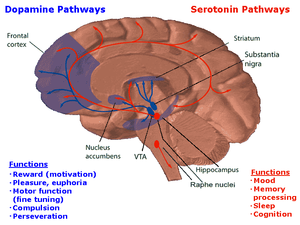- Mesolimbic pathway
-
The mesolimbic pathway is one of the dopaminergic pathways in the brain. The pathway begins in the ventral tegmental area of the midbrain and connects to the limbic system via the nucleus accumbens, the amygdala, and the hippocampus as well as to the medial prefrontal cortex. The mesolimbic dopamine system is widely believed to be a "reward" pathway, but that theory is not universally accepted.[1]
Contents
Anatomy
The following structures are considered to be a part of the mesolimbic pathway:
- Ventral Tegmental Area
- The ventral tegmental area (VTA) is a part of the midbrain. It consists of dopaminergic, GABAergic, and glutamatergic neurons.[2] The VTA communicates with the nucleus accumbens via the unmyelinated medial forebrain bundle.
- Nucleus Accumbens
- The nucleus accumbens is found in the ventral striatum and is composed of medium spiny neurons.[3][4] It is subdivided into limbic and motor subregions known as the shell and core.[2] The medium spiny neurons receive input from both the dopaminergic neurons of the VTA and the glutamatergic neurons of the hippocampus, amygdala, and medial prefrontal cortex. When they are activated by these inputs, the medium spiny neurons' projections release GABA onto the ventral pallidum.[2] The release of dopamine in this structure drives the mesolimbic system.
- Amygdala
- The amygdala is a large nuclear mass in the temporal lobe anterior to the hippocampus. It has been associated with the assignment of emotions, especially fear and anxiety. There are two, one in each temporal lobe, and their functions may be lateralized.
- Hippocampus
- The hippocampus is located in the medial portion of the temporal lobe. It is known for its association with double memory[clarification needed].
- Bed Nucleus of the Stria Terminalis
Controversy over mesolimbic dopamine function
There is some controversy regarding dopamine’s role in the reward system. Three hypotheses — hedonia, learning, and incentive salience — have been proposed as explanations for dopamine’s function in the reward system.[1] The hedonia hypothesis suggests that dopamine in the nucleus accumbens acts as a 'pleasure neurotransmitter'. Historically, in the late 1970s, it was found that some drugs of abuse involved dopamine activity, particularly in the nucleus accumbens, to cause the "high" or euphoric state. However, not all rewards or pleasurable things involve activation of the reward system, which may suggest that the mesolimbic pathway may not be just a system that works merely off enjoyable things (hedonia).[5] Learning, on the other hand, deals with predictions of future rewards and association formation. Studies have shown that rats that had their ventral tegmental area and nucleus accumbens destroyed do not lose their learning capabilities, but rather lack the motivation to work for a reward.[1] Incentive salience (wanting) stands out as a possible role for dopamine as it regards this molecule as being released when there is a stimulus worth working hard for, thus making an individual work to get it. This is one of the reasons why dopamine transport has been extensively studied in the case of ADD and ADHD. It is now widely understood that most people suffering from some form of attention deficit disorder most likely lack dopamine stimulation. This also explains why dopamine reuptake inhibitors and stimulants often dramatically improve symptoms of attention disorders. In self-administration studies, animals have been trained to give an operant response (lever press, nose poke, wheel turn, etc.) in order to obtain either a drug or mate. It has been shown that the animals will continue to perform the required task until the reward is received, or fatigue sets in.[2][5]
Clinical significance
Since the mesolimbic pathway is shown to be associated with feelings of reward and desire, this pathway is heavily implicated in neurobiological theories of addiction, schizophrenia, and depression.[6][7][8] Drug addiction, the loss of control over drug use or the compulsive seeking and taking of drugs despite adverse consequences, with the four major classes of abused drugs (psychostimulants, opiates, ethanol, and nicotine) are due to increased dopamine transmission in the limbic system-each by different mechanisms.[2][9] Like drug addiction, schizophrenia and depression have similar structural changes with dopamine transmission.[6]
Other dopamine pathways
The other dopamine pathways are:
References
- ^ a b c Berridge KC. 2007. The debate over dopamine's role in reward: the case for incentive salience. Psychopharmacology 191:391-431
- ^ a b c d e Pierce RC, Kumaresan V. 2006. The mesolimbic dopamine system: The final common pathway for the reinforcing effect of drugs of abuse? Neuroscience and Biobehavioral Reviews 30:215-38
- ^ Zhang TA, Maldve RE, Morrisett RA. 2006. Coincident signaling in mesolimbic structures underlying alcohol reinforcement. Biochemical Pharmacology 72:919-27
- ^ Purves D et al. 2008. Neuroscience. Sinauer 4ed. 754-56
- ^ a b Neill D. Emory University. Personal Interview. 14 Oct. 2008
- ^ a b Van den Heuval DMA, Pasterkamp RJ. 2008. Getting connected in the dopamine system. Progress in Neurobiology 85:75-93
- ^ Laviolette SR. 2007. Dopamine modulation of emotional processing in cortical and subcortical neural circuits: evidence for a final common pathway in schizophrenia? Schizoprenia Bulletin 33:971-981
- ^ Diaz J. 1996. How Drugs Influence Behavior: A Neurobehavorial Approach. Prentice Hall
- ^ Janhunen S, Ahtee L. 2007. Differential nicotinic regulation of the nigrostriatal and mesolimbic dopaminergic pathways: Implications for drug development. Neuroscience and Biobehavioral Reviews 31:287-314
See also
External links
- Diagram at Utah.edu
Neurotransmitter systems Acetylcholine BA/M Mesocortical pathway: Ventral tegmental area → Frontal cortex
Mesolimbic pathway: Ventral tegmental area → Nucleus accumbens
Nigrostriatal pathway: Pars compacta → Striatum
Tuberoinfundibular pathway: Hypothalamus → Pituitary glandSerotonin pathwaysAA Categories:- Central nervous system pathways
Wikimedia Foundation. 2010.

